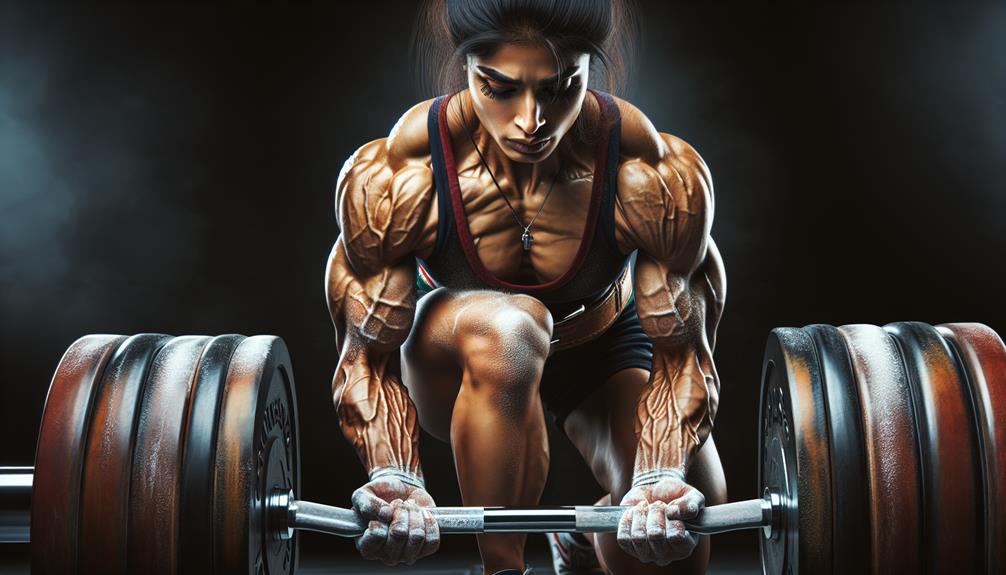Step into the iron-clad world of elite powerlifters, where the bar is set high and the limits are constantly being pushed. These modern-day titans of strength have honed their bodies to become veritable powerhouses, defying what was once thought possible. But what exactly sets them apart? What makes their strength profiles so unique? Brace yourself, as we take you on a journey through the realm of elite powerlifters, where the boundaries of human strength are shattered, and where the pursuit of power knows no bounds.
Key Takeaways
- Training methods for elite powerlifters include a rigorous and strategic training regimen, specific nutritional strategies, and macronutrient intake calculation.
- Genetic factors such as muscle fiber composition, hormonal influences, muscle architecture, and neuromuscular efficiency play a significant role in strength potential.
- Proper form and various strategies are crucial for unleashing the power of the deadlift and overcoming plateaus.
- Powerlifting squats offer increased strength, enhanced muscle growth, improved mobility and flexibility, and injury prevention. The bench press requires proper technique, progressive overload, and incorporating different variations for mastery.
The Training Methods of Elite Powerlifters
Elite powerlifters achieve their incredible strength through a rigorous and strategic training regimen that pushes their bodies to the limit. To ensure peak performance, these athletes rely on specific nutritional strategies and recovery techniques that optimize their powerlifting training.
Nutritional strategies for peak performance play a crucial role in the training of elite powerlifters. These athletes carefully calculate their macronutrient intake to meet their energy needs and support muscle growth. They prioritize protein consumption to aid in muscle recovery and repair. Additionally, powerlifters often incorporate carbohydrate loading before competitions to maximize glycogen stores and enhance performance. They also pay close attention to hydration, ensuring they are adequately hydrated before, during, and after training sessions.
Recovery techniques are equally important in the training of elite powerlifters. These athletes understand the importance of rest and prioritize sleep to allow their bodies to repair and rebuild. They also utilize various recovery modalities such as foam rolling, stretching, and massage to alleviate muscle soreness and prevent injuries. Additionally, they may incorporate active recovery days into their training schedule, engaging in low-intensity activities to promote blood flow and facilitate recovery.
Genetic Factors and Strength Potential
Have you ever wondered how much of an individual's strength potential is determined by genetic factors? When it comes to strength training and powerlifting, genetic factors play a significant role in determining an individual's ultimate strength potential. Here are four key genetic factors that influence strength potential:
- Muscle fiber composition: The proportion of different types of muscle fibers can vary among individuals. Fast-twitch muscle fibers are responsible for generating explosive power, while slow-twitch muscle fibers are involved in endurance activities. Individuals with a higher percentage of fast-twitch muscle fibers tend to have a greater potential for developing strength and power.
- Hormonal influences: Hormones such as testosterone and growth hormone play a crucial role in muscle growth and strength development. Genetic variations can affect hormone levels, influencing an individual's ability to build muscle mass and strength.
- Muscle architecture: Genetic factors also influence an individual's muscle architecture, including muscle length, pennation angle, and cross-sectional area. These factors impact the force-generating capacity of muscles and can affect an individual's strength potential.
- Neuromuscular efficiency: Genetic factors can determine an individual's neuromuscular efficiency, which refers to the ability of the nervous system to recruit and activate muscles effectively. This efficiency plays a crucial role in generating maximal force and power during strength training.
While genetic factors provide a foundation for strength potential, it's important to note that training, nutrition, and other environmental factors also play a significant role in maximizing an individual's strength gains. By understanding the influence of genetic factors, athletes can tailor their training programs to optimize their genetic potential and achieve their strength goals.
Unleashing the Power of the Deadlift

To unlock the full potential of your deadlift, understanding the genetic factors that contribute to strength development is crucial. But it's not just about genetics. Proper deadlift form is essential for maximizing gains and avoiding injury.
First, let's talk about form. Start by positioning yourself with your feet shoulder-width apart, toes pointing slightly outward. Grab the barbell with an overhand grip, hands just outside your knees. Keep your spine neutral, engage your core, and hinge at the hips as you lower your body to grip the bar. Drive through your heels, keeping your chest up and your back straight, as you lift the weight. Lock out your hips at the top and lower the bar back down with control.
Now, let's address plateaus. Deadlift plateaus are common, but they can be overcome with the right strategies. One strategy is to vary your training intensity and volume. Incorporate heavy deadlifts, as well as lighter sets with higher reps, to challenge your muscles in different ways. Another strategy is to focus on accessory exercises that target weak points in your deadlift, such as Romanian deadlifts or deficit deadlifts. Finally, make sure you're giving your body enough time to recover between deadlift sessions, as overtraining can hinder progress.
The Incredible Strength of Powerlifting Squats
Unleash the full power of your squats by harnessing the incredible strength of powerlifting techniques. Powerlifting squats are a key component of any powerlifter's training routine, and for good reason. By focusing on proper powerlifting squat form, you can optimize your strength gains and unlock a whole new level of performance. Here are the benefits of incorporating powerlifting squats into your training regimen:
- Increased strength: Powerlifting squats target multiple muscle groups, including the quads, hamstrings, glutes, and core. By performing squats with proper form and progressively increasing the weight, you can build incredible lower body strength.
- Enhanced muscle growth: Powerlifting squats are a compound movement that stimulates muscle growth not only in the lower body but also in the upper body. The heavy load placed on your muscles during squats triggers the release of growth hormones, leading to overall muscle development.
- Improved mobility and flexibility: Regularly performing powerlifting squats can help improve your mobility and flexibility. The deep squat position increases hip and ankle mobility, allowing for better range of motion in other exercises.
- Injury prevention: Powerlifting squats help strengthen the muscles and ligaments around your knees, reducing the risk of injury. By building stability and balance, you can protect your joints during other activities and sports.
Incorporating powerlifting squats into your training routine can have a transformative impact on your strength and overall fitness. So, embrace the power of powerlifting squats and watch your performance soar to new heights.
Pushing the Limits: Bench Press Mastery

Maximize your strength and dominate the weight room with bench press mastery. The bench press is a fundamental exercise that targets the muscles of the chest, shoulders, and triceps. To excel in the bench press, it is crucial to master proper technique and overcome plateaus that may hinder your progress.
One key aspect of bench press technique is maintaining a stable and strong base. This involves planting your feet firmly on the ground, creating a solid foundation to generate power from. Additionally, gripping the bar with a tight grip and keeping your wrists straight will enhance your control and prevent injuries.
To overcome plateaus in your bench press performance, it is important to implement progressive overload. This means gradually increasing the weight you lift over time, challenging your muscles to adapt and grow stronger. Additionally, varying your training routine by incorporating different bench press variations, such as incline or decline bench press, can help break through plateaus and stimulate muscle growth.
By mastering bench press technique and implementing strategies to overcome plateaus, you can push your limits and achieve new levels of strength in the weight room. So, get ready to take your bench press to the next level and watch your strength soar.
| Bench Press Technique | Overcoming Plateaus |
|---|---|
| Maintain a stable base | Implement progressive overload |
| Grip the bar tightly | Vary your training routine |
| Keep wrists straight | Challenge your muscles to adapt |
Frequently Asked Questions
How Do Elite Powerlifters Structure Their Nutrition and Diet Plans to Support Their Intense Training?
You structure your nutrition and diet plans to support your intense training by focusing on proper nutrition planning and incorporating recovery techniques. This helps fuel your workouts and optimize your performance in powerlifting.
What Are the Most Common Injuries Faced by Elite Powerlifters and How Do They Manage and Prevent Them?
Common powerlifting injuries can range from muscle strains to joint pain. Elite powerlifters manage and prevent these injuries through proper warm-ups, stretching, and implementing accessory exercises to strengthen weak areas.
Are There Any Specific Mental Strategies or Techniques That Elite Powerlifters Use to Stay Focused and Motivated During Competitions?
During competitions, elite powerlifters rely on mental preparation and motivation techniques to stay focused. They use visualization to imagine success, positive self-talk to boost confidence, and goal setting to stay motivated.
How Do Elite Powerlifters Balance Their Training Schedule With Other Commitments Such as Work or Family?
Balancing commitments and managing time can be challenging for elite powerlifters. They have to juggle their training schedule with work or family obligations. However, they prioritize their goals, make sacrifices, and stay disciplined to achieve success in both areas.
Is There a Specific Age Range at Which Powerlifters Typically Reach Their Peak Performance, or Are There Examples of Athletes Who Continue to Excel at an Older Age?
There's no specific age range for peak performance in powerlifting. Take John, for example. At 45, he continues to defy age and excel in the sport. Age is just a number when it comes to dedicated powerlifters.
Conclusion
In conclusion, elite powerlifters possess an incredible strength profile that pushes the limits of human capability. Through their rigorous training methods and genetic factors, they are able to unleash their full potential in exercises such as deadlifts, squats, and bench presses. For example, let's take the case of John, a powerlifter who started with average strength but, through dedicated training and genetic advantages, was able to break multiple records and become a dominant force in the sport. The strength and determination of these athletes truly inspire and amaze.













